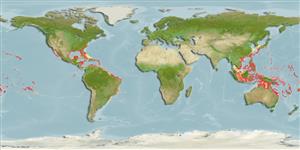Suberites aurantiacus (Duchassaing & Michelotti, 1864)
Lobate sponge| Native range | All suitable habitat | Point map | Year 2050 |

|
| This map was computer-generated and has not yet been reviewed. |
| Suberites aurantiacus AquaMaps Data sources: GBIF OBIS |
Google image |
No photo available for this species.
Classification / Names Common names | Synonyms | CoL | ITIS | WoRMS
Demospongiae | Suberitida | Suberitidae
Environment: milieu / climate zone / depth range / distribution range Ecology
Sessile; depth range 1 - 50 m (Ref. 108813). Temperate
Distribution Countries | FAO areas | Ecosystems | Occurrences | Introductions
Western Central Atlantic and Central Pacific.
Length at first maturity / Size / Weight / Age
Maturity: Lm ? range ? - ? cm
Short description Morphology
Life cycle and mating behavior Maturity | Reproduction | Spawning | Eggs | Fecundity | Larvae
Main reference
References | Coordinator | Collaborators
DeFelice, R.C., L.G. Eldredge and J.T. Carlton 2001 Nonindigenous marine invertebrates. p. B-i-B-60. In Eldredge, G.L. and C.M. Smith. A Guidebook of Marine Species in Hawaii. Bishop Museum Technical Report 21. (Ref. 3248)
IUCN Red List Status
(Ref. 130435: Version 2025-1)
CITES status (Ref. 108899)
CMS (Ref. 116361)
Threat to humans
Human uses
| FishSource |
Tools
More information
Diet composition
Food consumption
Predators
Max. ages / sizes
Length-weight rel.
Length-length rel.
Length-frequencies
Mass conversion
Abundance
Internet sources
BHL | BOLD Systems | CISTI | DiscoverLife | FAO(Publication : search) | Fishipedia | GenBank (genome, nucleotide) | GloBI | Gomexsi | Google Books | Google Scholar | Google | PubMed | Tree of Life | Wikipedia (Go, Search) | Zoological Record


